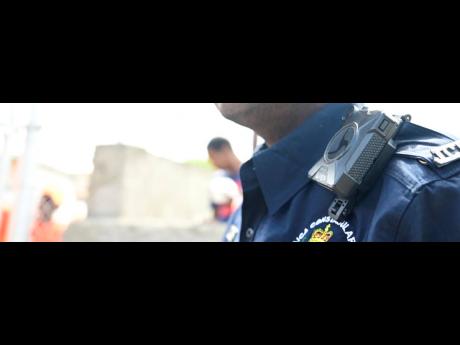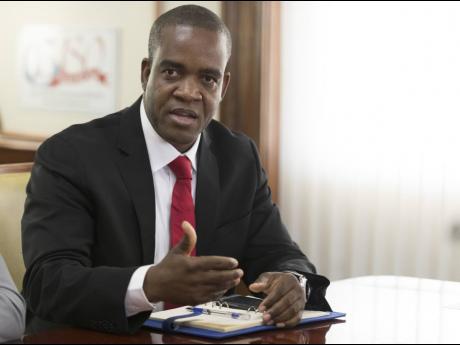Police body camera protocols under scrutiny
Limited coverage, activation failures draw criticism; traffic cop praises devices
Nine incidents of police failing to activate body cameras have triggered renewed scrutiny of the protocols intended to uphold transparency and accountability in interactions between the security forces and the public. These cases are among 14...
Nine incidents of police failing to activate body cameras have triggered renewed scrutiny of the protocols intended to uphold transparency and accountability in interactions between the security forces and the public.
These cases are among 14 incidents involving body-worn cameras (BWCs) recorded since October 2023, according to the Independent Commission of Investigations (INDECOM), the state agency charged with investigating allegations of abuse by the security forces.
The Jamaica Constabulary Force (JCF) has deployed just under 400 BWCs, highlighting the limited coverage, given the force’s strength of more than 12,000 officers, as acknowledged by INDECOM Assistant Commissioner Hamish Campbell.
Of the nine cases where officers failed to activate their BWCs, four were related to assaults, three involved non-fatal shootings, one was related to a traffic encounter, and the last involved an officer discharging his weapon to disperse a threatening crowd. The five additional cases where BWCs were turned on all involved alleged assaults. Some of them are still being investigated.
“For the few instances ... where body-worn cameras have been worn, a significant number of the officers haven’t turned them on in shooting incidents,” Campbell said in an interview with The Sunday Gleaner. “So, we’re left, with ‘Oh, I’m wearing a body-worn camera; I am trained in its use, but I forgot to turn it on’.”
Some footage has
been invaluable
He also noted that while some footage has been invaluable in protecting officers by corroborating their accounts, the overall numbers are still small.
“In one or two of the assault cases, it’s clear the officers actually didn’t assault the person making the complaint,” Campbell said, emphasising the benefit to officers of using the cameras. “They just need to put them on.”
INDECOM has not recommended disciplinary action against the nine officers who failed to activate their BWCs, a stance Campbell suggested is influenced by the relatively recent implementation of the technology and the focus on training and compliance.
“It is still early days culturally, the wearing of body-worn cameras ... . At this time, we’re not pursuing that,” he said.
However, the non-compliance issue was raised in a recent meeting with Police Commissioner Dr Kevin Blake, who Campbell said has committed to addressing the problem.
The camera is very important to reducing confrontation, according to a traffic cop who has been a regular user of BWCs.
“It has been great. It comes in handy,” said a policeman, who did not want to be named because he was not authorised to speak. “When we’re dealing with motorists, some of them don’t want to cooperate, so when we use the body camera, you get their attention. When we’re using the body camera, they say less. It’s there to defend us.”
INDECOM said there has been no case where disciplinary action has been recommended against a member of the police force based on a BWC recording.
The introduction of BWCs is seen as a strategic measure to embed accountability within the JCF and to help reduce allegations of abuse, extrajudicial killings, and controversies that have historically marred interactions between the police and citizens.
INDECOM itself was established in 2010 as the State’s primary response to the decades-old problems and the failure of previous initiatives. For the three-year period up to 2009, there were 733 police killings. In the succeeding three years, there were 687 deaths; and between 2014 and 2016, some 327 deaths were recorded. In 2019, there was a record-low figure of 86 deaths.
Commissioner Blake has publicly expressed his full support for the use of BWCs within the force.
Argument about the accountability
“My officers welcome it with open arms because they understand it ... so, this argument about the accountability that persons may be shying away from, let me dispel that and assure the members of the public that that is not the case,” Blake stated in August.
A series of questions sent by The Sunday Gleaner to the JCF on August 12 regarding the systems in place for BWCs, the checks and balances, and the public access regime, among other issues, remain unanswered.
The implementation of a previous BWC project faced hiccups with what National Security Minister Dr Horace Chang said was a challenge in getting the then devices fitted to the previous police uniforms.
The JCF’s use of BWCs is governed by an 18-page policy and Standing Operating Procedures (SOP) that took effect on November 11, 2021, replacing one that was published in 2017. The policy is scheduled for review every two years.
“Recordings of BWCs can be seen as that ‘built-in impartial witness’ that allows for increased efficiency and reliability, thereby engendering trust and confidence in the justice process,” the policy states.
It also outlines the responsibilities of various units within the force concerning BWCs, covering aspects such as procurement, issuance, use, care, maintenance, and disposal of the devices.
The assistant commissioner of police who heads the technology branch is responsible for all BWC recordings and the granting of access. Recordings are to be stored for up to 90 days before consideration for deletion.
The commissioner has stated that the force is prepared to increase its use of BWCs, having spent the last three years building out its communication infrastructure, including its data centre and network systems, to support new technologies such as body-worn cameras.
This is a critical component in ensuring the robustness and security of the system, as acknowledged by cybersecurity consultant Gavin Dennis. He emphasised that the system must include measures such as encryption to protect data, access controls, audit logs, software updates, data retention, and secure storage.
“All video footage should be encrypted both on the camera and during transfer to prevent unauthorised access. Conduct regular checks on the system to ensure all security measures are working and no footage has been altered or accessed improperly,” said Dennis, a director at G5 Cyber Security USA.
He said the automatic uploading of recordings would reduce the risk of footage being lost or tampered with.
INDECOM, which said it has not faced any roadblocks in accessing BWCs, has expressed satisfaction with the systems in place to ensure the integrity of recordings. “We are very much reliant and dependent on the information and trust that we have to have with the JCF,” Campbell said, outlining the transfer process for the recordings.
“They are sealed units, the chip and so… . When they are placed back in their cradles at the end of a tour of duty, the data is transferred electronically to the police command technology centre. No officer can take it off and start cropping it or editing it ... . We can see the movement of the camera, and then the data is transferred.”
However, despite progress, INDECOM remains eager to see a full rollout of the devices and has urged the JCF to prioritise the use of BWCs in planned operations involving specialist teams that search premises and apprehend wanted persons.
In an update in February 2023, the JCF said it started the deployment of BWCs in this latest round in September 2020, with 390 cameras deployed across 18 locations. An additional 400 were due later in 2023 and a further 1,000 are expected this financial year. Most of the early BWCs were mainly assigned to the police inspectorate, the Public Safety and Traffic Enforcement Branch, and several police divisions in Kingston and St Andrew.
“It is growing and it is getting further embedded, but it’s still a long way to go,” Campbell said, “We’re suggesting SWAT teams, Counter-Terrorism and Organised Crime group, the Special Ops, the Fugitive Apprehension Teams, … they should be provided with cameras over and above some of the patrols and the divisions, and then, therefore, when planned operations take place, we will be able to appreciate and understand more of these operations.”
At the end of July this year, 34 persons were shot and killed during 29 planned police operations, representing 38 per cent of the 90 persons shot and killed by cops during the seven months.
“That’s not what we want to see. There was a time it used to be at that level, but it dropped over the years to 10, 11 per cent,” Campbell said. The headline figure stood at 109 up to August 22.
Body-worn cameras were not issued or deployed in any of those incidents, INDECOM said.



